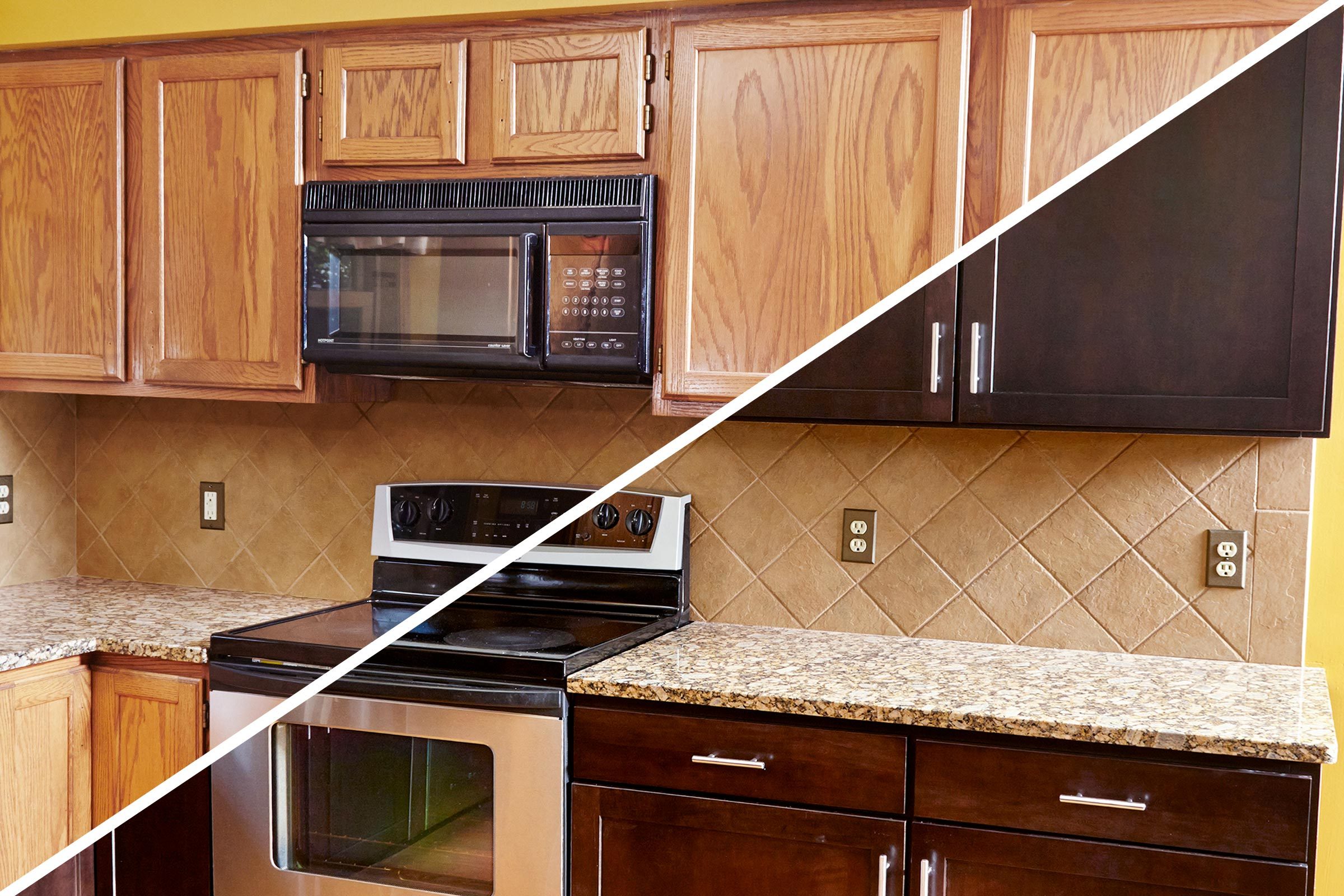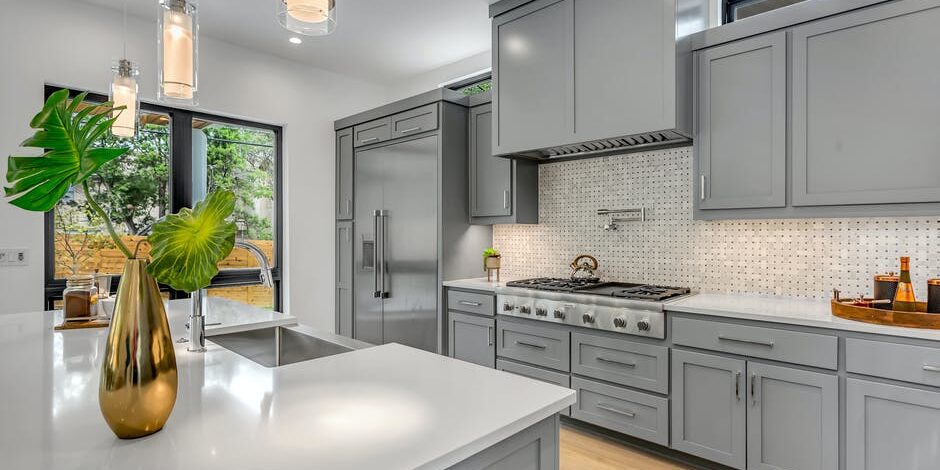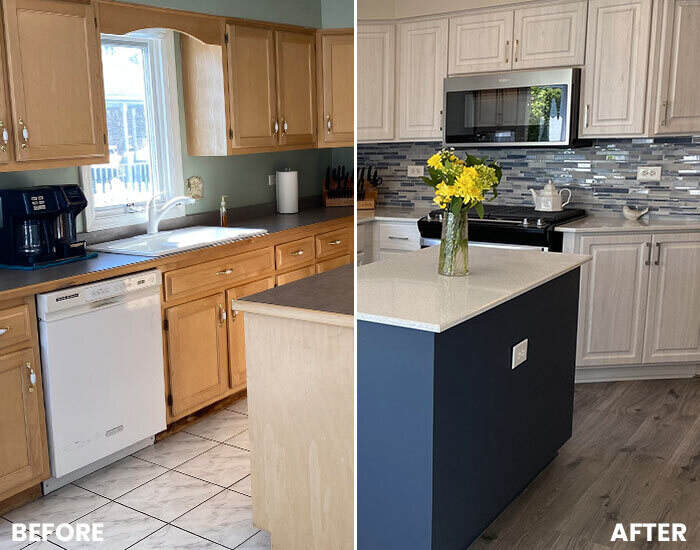To reface kitchen cabinets, start by removing the doors and drawers, then cover the front edges with wood veneer and install new cabinet doors with cup hinges. Refacing your kitchen cabinets is a cost-effective way to give your kitchen a fresh look without the hassle of a full renovation.
It involves updating the exterior of the cabinets by applying new veneer, replacing the doors, and adding new hardware. This DIY-friendly approach allows you to transform the appearance of your cabinets while keeping the existing layout and framework intact. Whether you want to update the style of your kitchen or enhance its functionality, refacing kitchen cabinets offers a budget-friendly and efficient solution.
With the right tools and materials, you can achieve professional-looking results and create a kitchen that reflects your personal style.

Credit: www.familyhandyman.com
Introduction To Cabinet Refacing
Refacing kitchen cabinets is a cost-effective and efficient way to give your kitchen a fresh new look without the hassle and expense of replacing the entire cabinetry. By simply replacing the cabinet doors and drawer fronts, and applying a veneer to the exposed surfaces, you can transform the appearance of your kitchen cabinets.
There are several benefits to choosing cabinet refacing over cabinet replacement:
- Cost-effective: Refacing cabinets is a more affordable option compared to completely replacing them.
- Time-saving: Refacing can be completed in a fraction of the time it takes to replace cabinets, minimizing disruption to your daily routine.
- Eco-friendly: Refacing reduces waste by reusing the existing cabinet frames, resulting in a more sustainable choice.
- Versatile design options: With refacing, you have the flexibility to choose from a variety of door styles, finishes, and hardware to create a customized look.
Before starting the refacing process, it’s important to assess the condition of your cabinets. Check for any structural issues, such as loose hinges or damaged frames, that may require repair before refacing. Ensure that the cabinet boxes are in good shape and suitable for refacing.
Once you’ve determined that your cabinets are suitable for refacing, you can proceed with the process, which typically involves removing the old doors and drawer fronts, cleaning and preparing the surfaces, applying the veneer, and installing the new doors and hardware.

Credit: premiercabinetpainting.com
Materials And Tools Needed
When it comes to refacing kitchen cabinets, there are a few essential tools and materials that you’ll need for the job. Firstly, you’ll need to choose the right veneer for your cabinets. Veneer comes in various options such as wood, laminate, or thermofoil, so be sure to select one that fits your desired aesthetic.
Next, you’ll need some essential tools to reface your cabinets. These include a utility knife and ruler or straight edge for cutting the veneer into strips. Additionally, you’ll need a sander to prepare the cabinet surface for the veneer application. A paint roller or brush will be necessary for applying adhesive, and a hammer or drill will be needed for attaching the new cabinet doors.
By following these guidelines and using the right materials and tools, you can easily reface your kitchen cabinets and give them a fresh new look without the need for a complete replacement.
Preparing Your Workspace
To prepare your workspace for refacing kitchen cabinets, start by protecting the surrounding areas. Cover floors and countertops with drop cloths to prevent any damage from dust or debris. Organize your materials and tools in a designated area to ensure easy access while working. Use painter’s tape to secure the drop cloths and protect adjacent surfaces from any accidental spills or splatters. Additionally, consider setting up a temporary workbench if you have sufficient space to lay out the cabinet doors and drawers for refacing. This will provide a stable surface for the refinishing process and help streamline the workflow.

Credit: www.improveitusa.com
Removing Cabinet Doors And Hardware
When refacing kitchen cabinets, the first step is to remove the cabinet doors and hardware. This allows for easier access to the cabinet frames and ensures that the refacing process goes smoothly. Before removing the doors, it is important to label them and the corresponding cabinet frames for easy reassembly. This will help avoid any confusion later on.
Once the doors are removed, the next step is to handle the hinges and handles. Carefully detach the hinges from the doors and cabinets, making sure to keep track of the screws. If any hardware needs to be replaced or updated, now is the time to do so. Clean and polish the handles to give them a refreshed look. By taking these steps, you are ready to proceed with the refacing process and transform the appearance of your kitchen cabinets.
Cleaning And Sanding Surfaces
To reface kitchen cabinets, start by cleaning and sanding the surfaces to remove any dirt and old finishes. This provides a smooth base for the new veneer or paint to adhere to, ensuring a professional-looking result. After sanding, you can apply the new finish or veneer to transform the cabinets without the cost of a full replacement.
Applying The Veneer
To reface kitchen cabinets, begin by removing the doors and drawers, then cover the front edges with peel-and-stick wood veneer. After that, install the new cabinet doors with easy-to-use cup hinges for a fresh and updated look. Refacing cabinets is a cost-effective and straightforward way to transform your kitchen without the need for a full replacement.
Refinishing Cabinet Doors And Drawers
Refacing kitchen cabinets is a cost-effective way to give your kitchen a fresh new look without the need for a full renovation. When it comes to refinishing cabinet doors and drawers, one of the first steps is sanding the door and drawer fronts. This helps to create a smooth surface for the stain or paint to adhere to. After sanding, you can then apply the stain or paint of your choice.
If you’re looking for a natural wood look, staining the cabinet doors and drawers can enhance the grain and bring out the beauty of the wood. On the other hand, if you prefer a more modern or colorful look, painting the doors and drawers can give your kitchen a fresh and vibrant feel. Whichever option you choose, make sure to properly prepare the surfaces and follow the manufacturer’s instructions for the stain or paint application process.
Reassembling And Installing Hardware
When reassembling and installing hardware for the refaced kitchen cabinets, it is essential to pay attention to attaching hinges and handles. Ensure that the hinges are securely attached to the cabinet doors, allowing for smooth opening and closing. Additionally, realign the doors and drawers to guarantee that they are level and properly positioned. This step is crucial for achieving a polished and professional look for the refaced cabinets.
Final Touches And Maintenance
When it comes to installing under-cabinet lighting, it is important to consider the final touches and maintenance required for your refaced kitchen cabinets. After refacing your cabinets, you can enhance the overall look and functionality by adding under-cabinet lighting. This not only provides additional illumination for your workspace but also creates a warm and inviting ambiance in your kitchen.
Caring for refaced cabinets is relatively simple. Regularly wipe down the surfaces with a mild soap and water solution to remove any dirt or spills. Avoid using abrasive cleaners or harsh chemicals, as they can damage the finish. It is also recommended to use soft cloths or sponges for cleaning, as abrasive materials can scratch the cabinet surface.
To maintain the longevity of your refaced cabinets, it is important to handle them with care. Avoid slamming the cabinet doors or drawers and use gentle, controlled movements when opening and closing them. Additionally, consider using protective pads or bumpers on the inside of the doors and drawers to prevent them from rubbing against each other.
By following these simple maintenance tips and adding the finishing touch of under-cabinet lighting, you can ensure that your refaced kitchen cabinets remain beautiful and functional for years to come.
Budget Tips For Refacing
When it comes to refacing kitchen cabinets, choosing cost-effective materials can help you stay within your budget. Opt for affordable options like peel and stick wood veneer to cover the front edges of the cabinets. This will give them a fresh, new look without breaking the bank. Additionally, consider refinishing the cabinets with a stick-on veneer to update their appearance. Another budget-friendly option is to repaint the cabinets with a new stain, varnish, or paint. This can be a cheaper alternative to completely replacing the cabinets.
If you’re looking to save money, you may consider refacing kitchen cabinets yourself. This process involves removing the doors and drawers of each cabinet, applying veneer strips to the front edges, and installing new cabinet doors with easy-to-install cup hinges. However, if you’re not confident in your DIY skills or want a more professional finish, hiring a professional refacing service might be a better option. They have the expertise and tools to ensure a high-quality refacing job.
Troubleshooting Common Issues
Refacing kitchen cabinets can be a simple and cost-effective way to give your kitchen a new look. Dealing with uneven surfaces can be a common issue when refacing cabinets. To fix this, you can use shims or filler to level the surfaces before applying the new veneer. Another common issue is peeling veneer, which can be addressed by removing the old veneer, sanding the surface, and applying new adhesive-backed veneer. It’s important to take the time to troubleshoot these common issues to ensure a successful cabinet refacing project.
Before And After: The Transformation
Refacing your kitchen cabinets is a great way to give your kitchen a fresh, new look without spending a lot of money. By refacing your cabinets, you can change the color, style, and hardware of your cabinets without having to completely replace them. There are many DIY tutorials available online that can guide you through the refacing process step by step. You can find videos on YouTube that provide an overview of the process, from measuring and sanding to installing new cabinet doors and hardware. Additionally, there are articles and blog posts available that provide tips and tricks for refacing your cabinets, as well as information on the pros and cons of refacing versus replacing. By doing your research and following the instructions carefully, you can easily transform your kitchen with refaced cabinets.
Frequently Asked Questions
Can I Reface My Kitchen Cabinets Myself?
Yes, you can reface your kitchen cabinets yourself. The process involves removing cabinet doors and drawers, covering the front edges with peel and stick veneer, and installing new cabinet doors with easy-to-install cup hinges. Refacing cabinets is an affordable way to update the look of your kitchen without having to replace the entire cabinet.
There are various DIY tutorials available online that provide step-by-step instructions on how to reface kitchen cabinets.
Is It Worth It To Reface Kitchen Cabinets?
Refacing kitchen cabinets is worth it for a cost-effective and efficient upgrade to your kitchen. It can provide a fresh look without the expense of full replacement. Plus, it’s a DIY-friendly project that can be completed relatively quickly.
What Is The Cheapest Way To Reface Kitchen Cabinets?
The cheapest way to reface kitchen cabinets is to strip the existing stain or paint and add new stain, varnish, or paint. Another option is to use stick-on veneer to refinish the cabinets. You can also consider distressing, whitewashing, or changing the cabinet handles to update the look without replacing them.
How Can I Redo My Kitchen Cabinets Without Replacing Them?
To redo your kitchen cabinets without replacing them, you can follow these steps: 1. Distress the cabinets. 2. Whitewash or use a two-tone color scheme. 3. Change the cabinet handles. 4. Add molding for a new look. 5. Change the kitchen door fronts.
6. Install under-cabinet lighting. These methods can give your cabinets a fresh and updated appearance without the need for replacement.
How Can I Reface My Kitchen Cabinets Myself?
You can reface your kitchen cabinets yourself by removing the doors and drawers, covering the front edges with peel and stick wood veneer, and hanging new cabinet doors with easy-to-install cup hinges.
Conclusion
Refacing kitchen cabinets is a cost-effective and convenient way to update the look of your kitchen without breaking the bank. With the right tools and techniques, you can transform your old and worn-out cabinets into beautiful and modern ones. Whether you choose to do it yourself or hire a professional, refacing your kitchen cabinets is definitely worth the investment.
So go ahead and give your kitchen a fresh and stylish new look that you’ll love for years to come!

